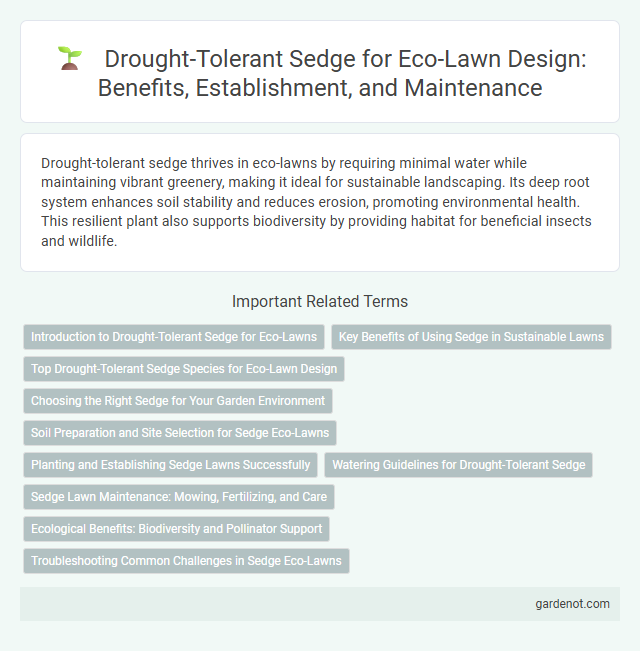Drought-tolerant sedge thrives in eco-lawns by requiring minimal water while maintaining vibrant greenery, making it ideal for sustainable landscaping. Its deep root system enhances soil stability and reduces erosion, promoting environmental health. This resilient plant also supports biodiversity by providing habitat for beneficial insects and wildlife.
Introduction to Drought-Tolerant Sedge for Eco-Lawns
Drought-tolerant sedge is a resilient grass alternative ideal for eco-lawns, thriving in low-water environments while maintaining vibrant green aesthetics. This sedge species reduces irrigation needs by up to 50%, making it a sustainable choice for water conservation efforts. Its deep root system enhances soil stability and supports biodiversity, promoting a healthier, eco-friendly lawn ecosystem.
Key Benefits of Using Sedge in Sustainable Lawns
Drought-tolerant sedge thrives in low-water conditions, significantly reducing irrigation needs and conserving water resources in sustainable lawns. Its deep root systems enhance soil stability and improve moisture retention, promoting healthy turf with minimal maintenance. Sedge also supports biodiversity by providing habitat for beneficial insects and enhancing ecosystem resilience in eco-lawn environments.
Top Drought-Tolerant Sedge Species for Eco-Lawn Design
Top drought-tolerant sedge species such as Carex pansa, Carex praegracilis, and Carex flacca offer exceptional resilience for eco-lawn design, requiring minimal irrigation while maintaining lush, green coverage. These sedges adapt well to varied soil types and provide erosion control, making them ideal for sustainable landscaping. Incorporating drought-tolerant sedges promotes water conservation and enhances biodiversity in eco-friendly lawn systems.
Choosing the Right Sedge for Your Garden Environment
Choosing the right drought-tolerant sedge for your garden involves assessing soil type, sunlight exposure, and moisture levels to ensure optimal growth and sustainability. Species such as Carex pansa and Carex praegracilis thrive in well-drained soils with moderate sun, making them ideal for eco-lawns in arid regions. Incorporating these sedges enhances water conservation efforts while maintaining a resilient, low-maintenance lawn.
Soil Preparation and Site Selection for Sedge Eco-Lawns
Drought-tolerant sedge thrives in well-drained, sandy or loamy soils with moderate fertility, making soil preparation critical for establishing a resilient eco-lawn. Selecting a site with partial to full sun exposure enhances sedge growth, while avoiding heavy clay soils and areas prone to waterlogging prevents root rot. Incorporating organic matter into the soil improves moisture retention and aeration, creating optimal conditions for drought-resistant sedge establishment.
Planting and Establishing Sedge Lawns Successfully
Plant drought-tolerant sedge during early spring or fall to ensure optimal root development before peak heat seasons. Prepare the soil by removing weeds and loosening the top layer to improve water infiltration and root penetration. Consistent watering for the first 4-6 weeks helps establish a robust root system, reducing irrigation needs as the sedge lawn matures.
Watering Guidelines for Drought-Tolerant Sedge
Drought-tolerant sedge requires minimal watering once established, typically needing only 1 inch of water per week during dry periods to maintain healthy growth. Water deeply and infrequently to encourage deep root development, which enhances the sedge's natural drought resistance. Avoid overwatering, as excessive moisture can lead to root rot and reduced drought tolerance.
Sedge Lawn Maintenance: Mowing, Fertilizing, and Care
Drought-tolerant sedge lawns require minimal mowing, usually once every 2-3 weeks, to maintain optimal height and encourage dense growth while conserving water. Fertilizing should be done sparingly, ideally with a slow-release, low-nitrogen fertilizer in early spring to support root development without promoting excessive top growth. Regular care includes removing debris, monitoring for pests, and occasional deep watering during extended dry periods to ensure resilience and health.
Ecological Benefits: Biodiversity and Pollinator Support
Drought-tolerant sedge contributes to eco-lawns by enhancing biodiversity through its adaptability to arid conditions and support for local wildlife habitats. This native grass alternative provides essential nectar and pollen sources for pollinators like bees and butterflies, promoting ecosystem resilience. Its low water requirements reduce irrigation demand, making it an environmentally sustainable choice for sustainable landscape management.
Troubleshooting Common Challenges in Sedge Eco-Lawns
Drought-tolerant sedge in eco-lawns often faces challenges such as patchy growth and discoloration due to uneven watering or soil compaction. Ensuring proper soil aeration and consistent moisture levels helps maintain healthy, vibrant sedge stands. Regular monitoring for pests like sedge mites and adjusting irrigation schedules can prevent common issues and promote drought resilience.
Drought-tolerant sedge Infographic

 gardenot.com
gardenot.com